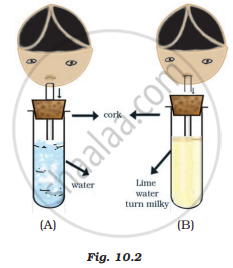Advertisements
Advertisements
Question
Choose the odd one out in the following groups of four items each:
Hairy, Moist, Nostril, Vocal cord
Solution
Vocal cord
APPEARS IN
RELATED QUESTIONS
What are the different ways in which glucose is oxidized to provide energy in various organisms?
During heavy exercise, we get cramps in the legs due to the accumulation of ______.
The exchange of respiratory gases in the cells of plants occurs by the process of _______________
(a) Osmosis
(b) Diffusion
(c) Glycolysis
(d) exhalation
Name the pores in a leaf through which respiratory exchange of gases takes place.
Name the areas in a woody stem through which respiratory exchange of gases takes place.
State whether the following statement is true or false:
Fish and earthworm exchange gases during respiration in the same way.
Explain why, when air is taken in and let out during breathing, the lungs always contain a residual volume of air.
Describe the process of respiration in Amoeba. State whether it is anaerobic respiration or aerobic respiration.
Describe the process of respiration in the following part of a plant:
Root
Describe the process of respiration in the following part of a plant:
Stem
Describe the process of respiration in the following part of a plant:
Leaves
Why is the rate of breathing in aquatic organisms much faster than in terrestrial organisms?
"Respiration is a vital function of the body". Justify this statements.
Internal respiration may be defined as:
Which of the following statements are true about respiration?
(i) during inhalation, ribs move inward and diaphragm is raised.
(ii) the gaseous exchange takes place in the alveoli.
(iii) haemoglobin has greater affinity for carbon dioxide than oxygen.
(iv) alveoli increase surface area of the exchange of gases
A, B and C are three living organisms. The organism A is a unicellullar fungus which can live without air. It is used in the commercial production of an organic compound P from molasses. The organism B is a unicellular animal which lives in water and feeds and moves by using pseudopodia. It breathes through an organelle Q. The organism C is a tiny animal which acts as a carrier of malarial parasite. It breathes and respires through a kind of tiny holes R and air-tubes S in its body.
(a) What are organisms (i) A (ii) B, and (iii) C?
(b) Name (i) P (ii) Q (iii) R, and (iv) S.
(c) Which organism/organisms undergo aerobic respiration?
(d) Which organism/organisms undergo anaerobic respiration?
Veins and arteries carry blood. Which of these carry blood away from the heart?
Fill in the following blanks with suitable words:
The ___________ blood cells make antibodies whereas ___________ blood cells help in respiration.
An animal in which the oxygenation of blood does not take place in the lungs is:
Answer the following in one word.
What is the muscular sheet below the lungs called?
Answer the following in detail.
Explain the process of Cellular Respiration.
Name the body structure concerned with the given functional activity:
Prevents food from entering the trachea during swallowing.
Match the items in Column A with those in Column B.
|
Column A |
Column B |
|
Cartilaginous |
Epiglottis |
|
Large surface area |
Diaphragm |
|
Breathing movements |
Bronchi |
|
Voice |
Alveoli |
|
Complemental air |
Larynx |
|
Swallowing |
Extra inhalation |
Give Suitable Explanation for the Following :
Why do you shiver and why do your teeth chatter when it is very cold in winter?
Given below is an overall chemical reaction of a certain process:
C6H12O6→LacticAcid+2ATP+Heat energy
Is this reaction applicable to animals or to plants or to both animals and plants?
Draw a diagram of the human respiratory system and label - pharynx, trachea, lungs, diaphragm and alveolar sac on it.
____________ refers to a biochemical process of oxidation of organic compounds in an orderly manner for the liberation of chemical energy in the form of ATP.
During the process of exhalation, the ribs move
Observe Figure 10.2 carefully and answer the following questions.

- Which process is being tested in the activity?
- What is the result of the activity? Give reasons.
